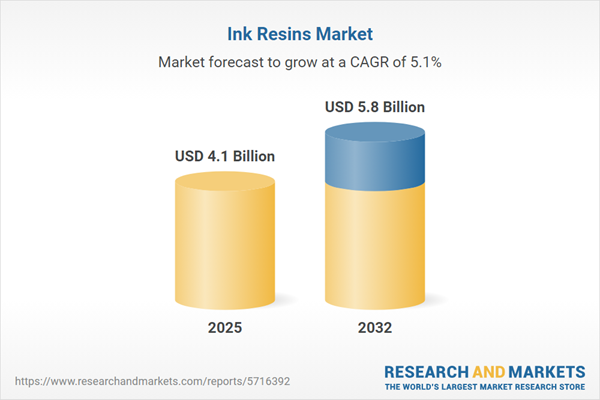Speak directly to the analyst to clarify any post sales queries you may have.
The ink resins market is undergoing significant transformation as organizations align with evolving print requirements and environmental priorities. Industry leaders are adopting new technologies, optimizing sourcing, and updating operational models to drive market resilience and sustained growth.
Market Snapshot: Ink Resins Market Growth & Trends
The ink resins market demonstrates robust momentum, shaped by innovation, compliance, and the continuing shift to advanced digital print technologies. Senior procurement and operations executives are steering investments in resource-efficient processes to drive sustainability across multiple production channels. Responding to dynamic industry requirements, stakeholders are streamlining supply networks and focusing on sourcing agility to address variable customer demands. The industry is projected to achieve a compound annual growth rate (CAGR) of 5.08% through 2032, highlighting ongoing adaptation driven by digitalization and the adoption of responsible resin solutions. This evolving landscape positions companies to respond deftly to shifting regulatory and operational expectations across global regions.
Scope & Segmentation of the Ink Resins Market
- Resin Types: Acrylic, alkyd, epoxy, phenolic, polyamide, polyurethane, rosin, and unsaturated polyester resins deliver tailored solutions for commercial printing, specialty markets, and various industrial uses, addressing a wide array of technical and performance needs.
- Technology Platforms: Energy-curable, powder, solvent-based, water-based, dispersion, and emulsion systems enable organizations to meet regulatory targets while maintaining operational flexibility for diverse print and packaging applications.
- Printing Processes: Digital, electrophotography, inkjet, flexographic, gravure, offset, and screen methodologies facilitate customized production for sectors such as packaging, labeling, publishing, and specialty runs.
- End-Use Industries: Labels, packaging, publishing, and textiles sectors benefit from digital workflow advancements and the ability to adapt operations to changing logistical and market conditions.
- Distribution Channels: Direct sales and established distribution networks provide procurement teams with the flexibility to align their strategies according to project scale, geographic focus, and regional risk considerations.
- Regional Coverage: The Americas, Europe, Middle East, Africa, and Asia-Pacific regions each present distinct operational, compliance, and supplier engagement dynamics that inform resource allocation and entry strategies for global players.
- Company Analysis: Major enterprises, including BASF SE, Dow Inc., Arkema S.A., Evonik Industries AG, Eastman Chemical Company, Allnex Belgium S.A., Covestro AG, Hexion Inc., Mitsubishi Chemical Corporation, and Synthomer plc, shape innovation and set operational standards throughout the global supply chain.
Key Takeaways for Senior Decision-Makers
- Sustainability concerns are fueling demand for water-based and energy-curable resins, leading to increased adoption of environmentally responsible manufacturing practices and support for long-term growth initiatives.
- Digital print infrastructure upgrades are strengthening supply chain adaptability by allowing faster operational adjustments to changing business environments.
- Bio-based sourcing strategies empower procurement functions to advance environmental commitment and differentiate their organizations in a competitive landscape.
- Closer collaboration between manufacturers, suppliers, and formulation specialists is enhancing value chain resilience and supporting the development of solutions aligned with evolving industry demands.
- Procurement teams are optimizing tactics to address specific regional constraints, ensuring efficiency gains in established markets and pursuing expansion opportunities in Asia-Pacific through technological investments.
Tariff Impact and Supply Chain Response
Recent tariff changes in the United States have heightened costs for resin categories such as epoxy, acrylic, and polyurethane. In response, organizations are boosting domestic production, diversifying supply sources, and increasing supplier collaboration. Strategic risk management and agile sourcing approaches are now central to maintaining operational stability and mitigating trade disruptions throughout the supply chain.
Methodology & Data Sources
Findings are derived from executive interviews, in-depth field research, and proprietary market intelligence platforms. Validation is achieved through cross-verification with independent market reports and patent analysis, ensuring relevant and reliable insights for senior decision-makers in the ink resins market.
Why This Report Matters
- Equips decision-makers with actionable data to guide technology deployment, meeting digital print and regulatory expectations for operational competitiveness.
- Delivers comprehensive segment analysis and competitor insights, strengthening sourcing strategies while enhancing compliance frameworks.
- Enables senior leaders to anticipate market risks and seize opportunities as trade policies and operational environments evolve.
Conclusion
The ink resins market’s evolution is marked by the integration of emerging technologies and collaborative industry efforts. Senior executives are positioned to navigate regulatory shifts, drive digital transformation, and reinforce operational stability.
Additional Product Information:
- Purchase of this report includes 1 year online access with quarterly updates.
- This report can be updated on request. Please contact our Customer Experience team using the Ask a Question widget on our website.
Table of Contents
3. Executive Summary
4. Market Overview
7. Cumulative Impact of Artificial Intelligence 2025
Companies Mentioned
The companies profiled in this Ink Resins market report include:- BASF SE
- Dow Inc.
- Arkema S.A.
- Evonik Industries AG
- Eastman Chemical Company
- Allnex Belgium S.A.
- Covestro AG
- Hexion Inc.
- Mitsubishi Chemical Corporation
- Synthomer PLC
Table Information
| Report Attribute | Details |
|---|---|
| No. of Pages | 191 |
| Published | November 2025 |
| Forecast Period | 2025 - 2032 |
| Estimated Market Value ( USD | $ 4.1 Billion |
| Forecasted Market Value ( USD | $ 5.8 Billion |
| Compound Annual Growth Rate | 5.0% |
| Regions Covered | Global |
| No. of Companies Mentioned | 11 |









